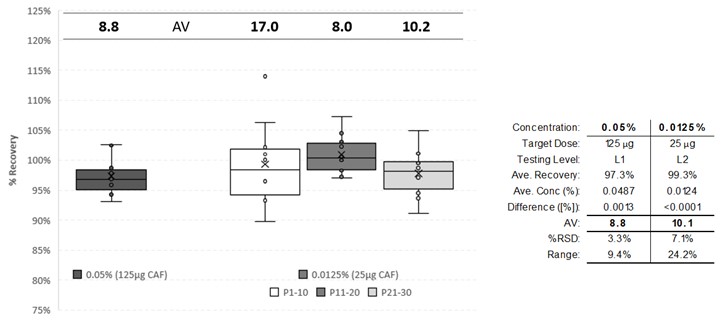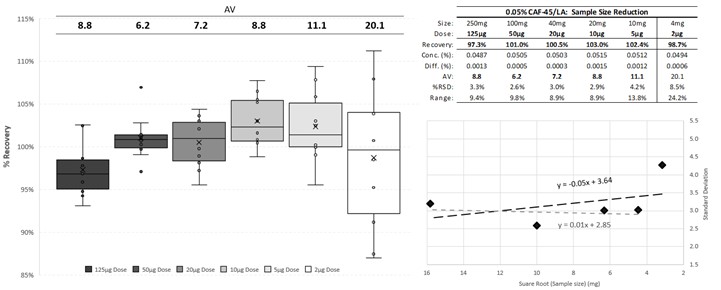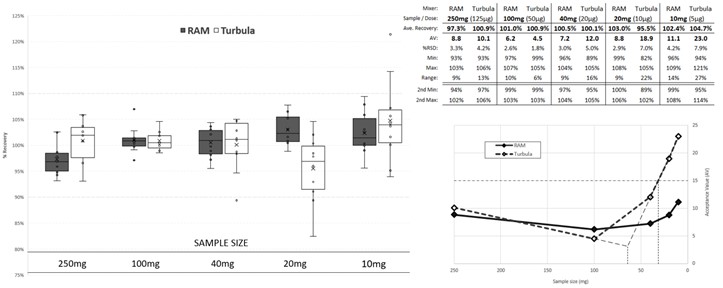Formulation and Delivery - Chemical
Category: Late Breaking Poster Abstract
(M1130-12-79) Use of Resonant Acoustic Technology for Ultra-Low Dose Blending in a Single-Step Mixing Process
Monday, October 23, 2023
11:30 AM - 12:30 PM ET

Kyle A. Frey, B.S. (he/him/his)
Formulation Scientist III
Quotient Sciences
Garnet Valley, Pennsylvania, United States
Kyle A. Frey, B.S. (he/him/his)
Formulation Scientist III
Quotient Sciences
Garnet Valley, Pennsylvania, United States- HB
Helen Baker, Ph.D.
Quotient Sciences
Garnet Valley, Pennsylvania, United States - DE
David A. Engers, Ph.D.
Quotient Sciences
Garnet Valley, Pennsylvania, United States - DP
Dale Purcell, Ph.D.
Chemical Microscopy
West Lafayette, Indiana, United States
Presenting Author(s)
Main Author(s)
Co-Author(s)
Purpose: To evaluate the use of resonant acoustic mixing (RAM) technology for homogenous blending of a morphologically challenging model API in low-dose concentrations ( < 0.1% w/w) and methods of optimizing blend uniformity (BU).
Methods: Excipients were accurately weighed and a portion (~50%) transferred into a glass jar with screw-top lid. Caffeine (CAF) was weighed using a microbalance, transferred onto the excipient bed, and sandwiched between the remaining excipient. Batches of ~95 g were prepared in this way, leaving about 10–20% void space above the powder bed. Mixing was carried out using a LabRAM I benchtop mixer (Resodyn™, WI, USA) under conditions of 80G (785 m/s2) acceleration and 135 seconds mixing time for ultra-low blends containing 0.05% and 0.0125% CAF (w/w). Blend uniformity was assessed in n=10 preparations of powder mixture. Sampling amounts were taken at the level of the intended CAF dose (2–125 μg) and ranged from 4–250 mg. Side-by-side comparative studies for select blends were performed using a Turbula® Model T2F Shaker Mixer (WAB Group, Mettenz, Switzerland) using identical sample preparation and loading methods into the mixing vessel. 75 g batch sizes were prepared and mixed for 5 minutes at a rotational velocity of 51 RPM. HPLC analysis of BU samples was performed using a previously validated method [1].
Results: Upon optimization, RAM technology was found capable of accurately preparing homogeneous mixtures of < 0.1% w/w CAF within 135 seconds, with CAF dilutions in the excipient matrices of up to 1 in 8000. Fig. 1 displays each set of BU results for the 0.05% w/w and 0.0125% w/w blends, sampled in units of powder containing target doses of 125 μg and 25 μg CAF, respectively. L1 testing of the 0.05% w/w blend revealed an AV score of 8.8, and an RSD of 3.3%. An AV of 10.1 was determined for the 0.0125% w/w blend based on L1/L2 testing. Assay results from 29 of the 30 total samples were within the range of 90%–110% (with a lone outlier at 113.9%), and average blend concentration of 0.0124% w/w. The degree of microscale mixing capabilities of RAM was assessed on the 0.05% formulation using increasingly smaller sample masses, from 250 mg down to 4 mg (correlating to 125–2 μg CAF, respectively). The results are summarized in Fig. 2, which depicts each set of BU results according to the specific sample size. The corresponding table shows how L1 criteria were met for all sample sizes down to 10 mg, where as little as 5 μg CAF could be reproducibly dosed with an accuracy of 102.4% and AV of 11.1. A slope of 0.05 was calculated from plots of square root sample size versus standard deviation, indicating the samples are micro-mixed. L1 testing was observed to fail only as CAF content approached 2 μg, despite target precision to 26 nanograms (98.7% label claim). In contrast, results of side-by-side analysis with turbula mixing demonstrated reduced capacity for mixing to reach microscale levels, as illustrated in Fig. 3. BU results from 20 mg and 10 mg sample masses failed to pass L1 criteria, where AV values 2x higher than RAM were recorded. Although AV was passed at the 40 mg level, a distinct deterioration in performance is already visible as %RSD is increased to almost 2.5x that of RAM. Comparatively, at the same sample sizes, assay results from RAM showed the potency of each preparation to be within 100% ± 5%.
Conclusion: In this report, we present the first instance of a < 0.1%w/w blend, where aa morphologically challenging API homogenously mixed in a single step using RAM technology. Microscale mixing was evidenced from BU results of the 0.05% blend using n=50 data points, and uniformity was demonstrated from samples containing as low as 5 μg CAF. The potential for this technology to prepare low-dose blends has been demonstrated at levels 60x smaller a previous report [2] and 3,000x lower than first recorded in the earliest RAM reports [3]. Overall, the study demonstrates for the first time the use of RAM technology to formulate single-digit microgram doses in ultra-low concentrations.
References: [1] Aminu N, Chan SY, Khan NH, Farhan AB, Umar MN, Toh SM. A Simple Stability-Indicating HPLC Method for Simultaneous Analysis of Paracetamol and Caffeine and Its Application to Determinations in a Fixed-Dose Combination Tablet Form. Acta Chromatogr. 2019;31:85-91. https://doi.org/10.1556/1326.2018.00354.
[2] Gupta S, Pu YE, Li M, Li Z, Osorio JG Assessment of Resonant Acoustic Mixing for Low-Dose Pharmaceutical Blends. AAPS PharmSciTech 2022;23(5):126. https:/doi.org/doi:10.1208/s12249-022-02262-4.
[3] Osorio JG, Guillermo J Macro and Micro Characterization of Powder Mixing. by Resonant Acoustic Mixing. Rutgers University (2014). https://doi.org/doi:10.7282/T3NK3CB1.
Acknowledgements: The authors declare no conflicts of interest or other matters which would aberrate the integrity of this work. All funding internally sourced.
 Fig. 1 BU results from 0.05% and 0.0125% blends of CAF/LA. All three sets of n=10 preparations from L2 testing of the 0.0125% are shown separately, with AV scores indicated above each blend. Averaged values from L1 and L2 results are reported in the table.
Fig. 1 BU results from 0.05% and 0.0125% blends of CAF/LA. All three sets of n=10 preparations from L2 testing of the 0.0125% are shown separately, with AV scores indicated above each blend. Averaged values from L1 and L2 results are reported in the table. Fig. 2 Sample size effects on RAM performance for 0.05% CAF-45/LA blends.(Left) Raw results from BU testing of 250–4 mg sample sizes for target doses of 125–2 μg CAF, with corresponding AV scores. Note that even at the 2 μg level, all n=60 total preparations were within the limits of the abscissa marking ±15% label claim potency. and ±10% excluding this set.(Right Top) Summary findings from BU data. (Right Bottom) Scale of micromixing in BU samples. A slope of 0.05 was found from the n=5 data points shown (250–10 mg), while a slope of 0.01 could be determined from the range of 250–20 mg sample masses.
Fig. 2 Sample size effects on RAM performance for 0.05% CAF-45/LA blends.(Left) Raw results from BU testing of 250–4 mg sample sizes for target doses of 125–2 μg CAF, with corresponding AV scores. Note that even at the 2 μg level, all n=60 total preparations were within the limits of the abscissa marking ±15% label claim potency. and ±10% excluding this set.(Right Top) Summary findings from BU data. (Right Bottom) Scale of micromixing in BU samples. A slope of 0.05 was found from the n=5 data points shown (250–10 mg), while a slope of 0.01 could be determined from the range of 250–20 mg sample masses. Fig. 3 Limits in mixing performance for RAM and Turbula. (Left & Right Top) Summary findings of side-by-side analysis of identical binary mixtures of 0.05% CAF/LA. (Right Bottom) Trending AV scores for both mixers, with Turbula data extrapolated for failure analysis showing sample masses marking projected AV failure and beginning of performance deterioration.
Fig. 3 Limits in mixing performance for RAM and Turbula. (Left & Right Top) Summary findings of side-by-side analysis of identical binary mixtures of 0.05% CAF/LA. (Right Bottom) Trending AV scores for both mixers, with Turbula data extrapolated for failure analysis showing sample masses marking projected AV failure and beginning of performance deterioration.